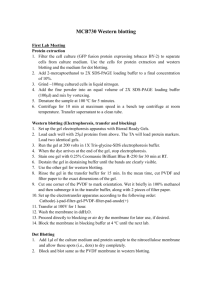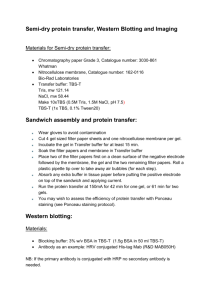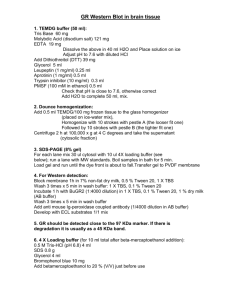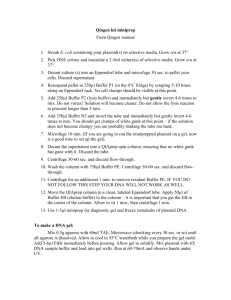ReadyBlot™ 10 Min. Western Transfer Buffer
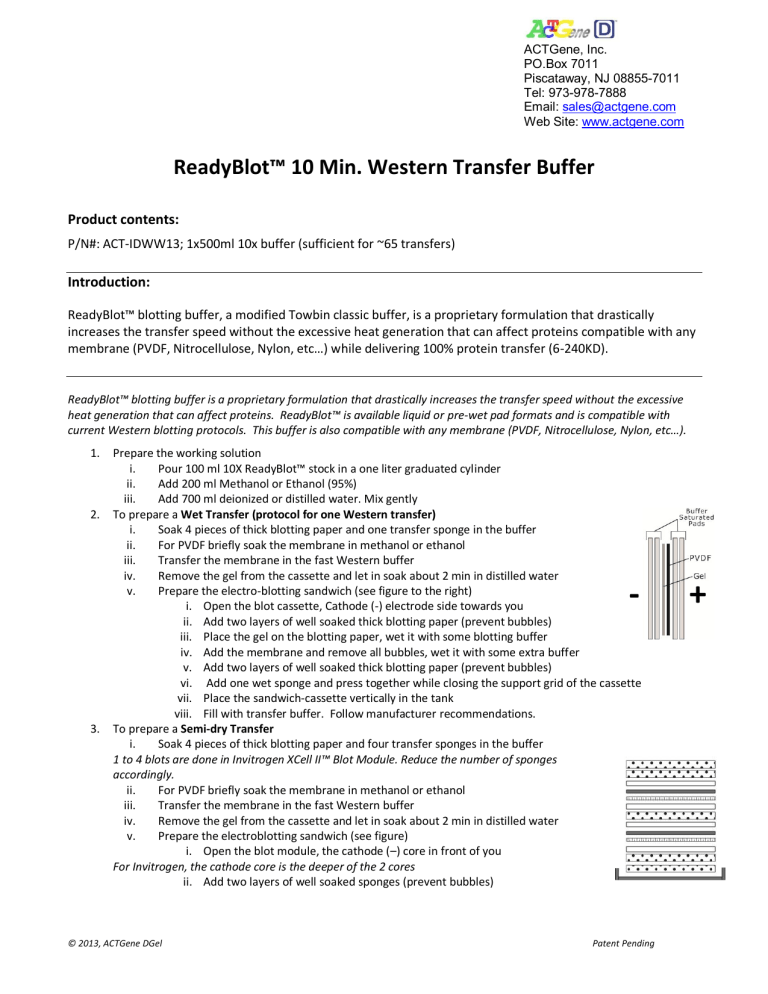
ACTGene, Inc.
PO.Box 7011
Piscataway, NJ 08855-7011
Tel: 973-978-7888
Email: sales@actgene.com
Web Site: www.actgene.com
ReadyBlot™ 10 Min. Western Transfer Buffer
Product contents:
P/N#: ACT-IDWW13; 1x500ml 10x buffer (sufficient for ~65 transfers)
Introduction:
ReadyBlot™ blotting buffer, a modified Towbin classic buffer, is a proprietary formulation that drastically increases the transfer speed without the excessive heat generation that can affect proteins compatible with any membrane (PVDF, Nitrocellulose, Nylon, etc…) while delivering 100% protein transfer (6-240KD).
ReadyBlot™ blotting buffer is a proprietary formulation that drastically increases the transfer speed without the excessive heat generation that can affect proteins. ReadyBlot™ is available liquid or pre-wet pad formats and is compatible with current Western blotting protocols. This buffer is also compatible with any membrane (PVDF, Nitrocellulose, Nylon, etc…).
1.
Prepare the working solution i.
Pour 100 ml 10X ReadyBlot™ stock in a one liter graduated cylinder ii.
Add 200 ml Methanol or Ethanol (95%) iii.
Add 700 ml deionized or distilled water. Mix gently
2.
To prepare a Wet Transfer (protocol for one Western transfer) i.
Soak 4 pieces of thick blotting paper and one transfer sponge in the buffer ii.
For PVDF briefly soak the membrane in methanol or ethanol iii.
Transfer the membrane in the fast Western buffer iv.
Remove the gel from the cassette and let in soak about 2 min in distilled water v.
Prepare the electro-blotting sandwich (see figure to the right) i.
Open the blot cassette, Cathode (-) electrode side towards you ii.
Add two layers of well soaked thick blotting paper (prevent bubbles) iii.
Place the gel on the blotting paper, wet it with some blotting buffer
- iv.
Add the membrane and remove all bubbles, wet it with some extra buffer v.
Add two layers of well soaked thick blotting paper (prevent bubbles) vi.
Add one wet sponge and press together while closing the support grid of the cassette vii.
Place the sandwich-cassette vertically in the tank viii.
Fill with transfer buffer. Follow manufacturer recommendations.
3.
To prepare a Semi-dry Transfer i.
Soak 4 pieces of thick blotting paper and four transfer sponges in the buffer
1 to 4 blots are done in Invitrogen XCell II™ Blot Module. Reduce the number of sponges accordingly. ii.
For PVDF briefly soak the membrane in methanol or ethanol iii.
Transfer the membrane in the fast Western buffer iv.
Remove the gel from the cassette and let in soak about 2 min in distilled water v.
Prepare the electroblotting sandwich (see figure) i.
Open the blot module, the cathode (–) core in front of you
For Invitrogen, the cathode core is the deeper of the 2 cores ii.
Add two layers of well soaked sponges (prevent bubbles)
+
© 2013, ACTGene DGel Patent Pending
ACTGene, Inc.
PO.Box 7011
Piscataway, NJ 08855-7011
Tel: 973-978-7888
Email: sales@actgene.com
Web Site: www.actgene.com
iii.
Add two layers of well soaked thick blotting paper (prevent bubbles) iv.
Place the gel on the blotting paper, wet it with little extra buffer v.
Add the membrane and remove all bubbles, wet it with little extra buffer vi.
Add two layers of well soaked thick blotting paper (prevent bubbles) vii.
Add two wet sponges (prevent bubbles) viii.
Repeat to add more electroblotting sandwiches ix.
Close the Western apparatus pressing together the sponges x.
Follow manufacturer recommendations.
4.
Electro-blotting conditions
Current Minimal transfer time*
We recommend using constant current.
330 mA 15-20 min
Optimized conditions for 6 to 12% gels
400 mA 10-15 min
*Note that these conditions are optimized for a 1 mm gel and might vary based on your gel composition and thickness. When adapting ReadyBlot™ to your needs, use the prestained markers of your run to observe if there are still protein bands in the gel and correct your transfer conditions accordingly.
Start adjustments by increasing or reducing mA, not time.
Storage Conditions
Store these bottles at RT 2 years
For Research Use Only
© 2013, ACTGene DGel Patent Pending
